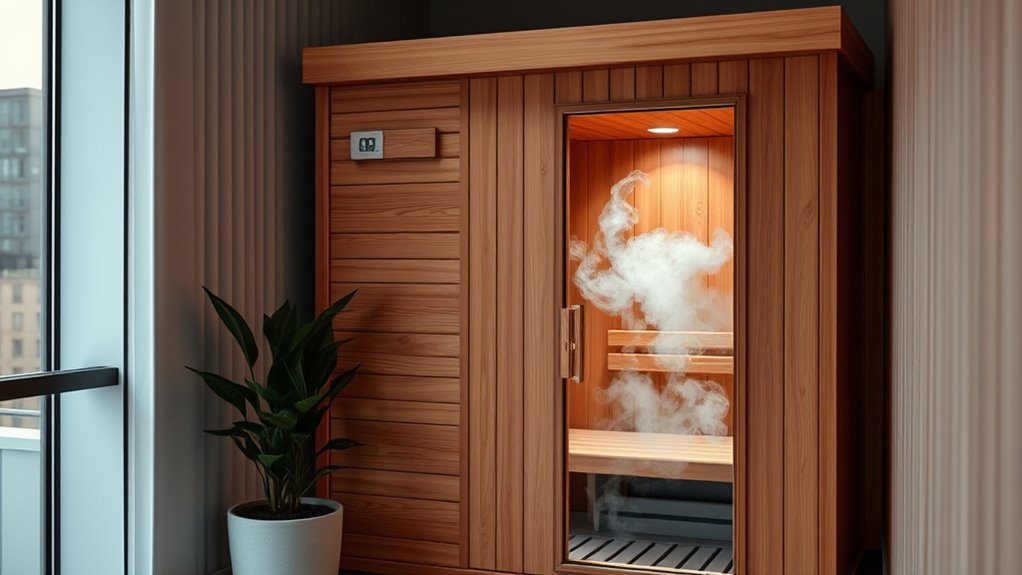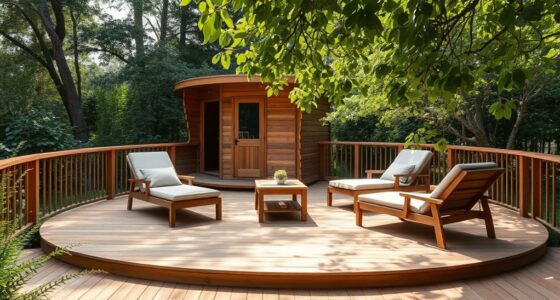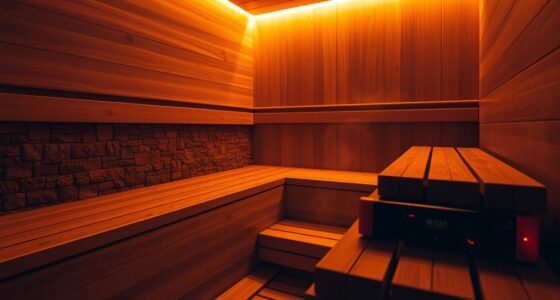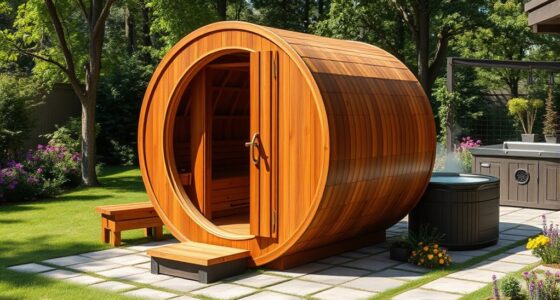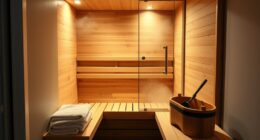To construct a sauna in your small apartment or condo, select a portable or foldable infrared model that fits in tight spaces. Position it near an exterior wall with ventilation options, and use exhaust fans or air purifiers to manage humidity and airflow. Regularly monitor moisture levels and consider adding dehumidifiers to prevent mold. Planning carefully around regulations and ventilation guarantees safety and comfort—keep going to discover more tips for a successful setup.
Key Takeaways
- Choose a portable, foldable infrared sauna designed for small spaces to minimize installation complexity.
- Ensure proper ventilation with exhaust fans, windows, or vents to manage heat and humidity buildup.
- Position the sauna near exterior walls and use dehumidifiers to prevent moisture damage and mold growth.
- Select lightweight, easy-to-assemble units that comply with building regulations and do not disturb neighbors.
- Regularly monitor humidity levels and maintain good airflow to ensure safety and comfort in your apartment.
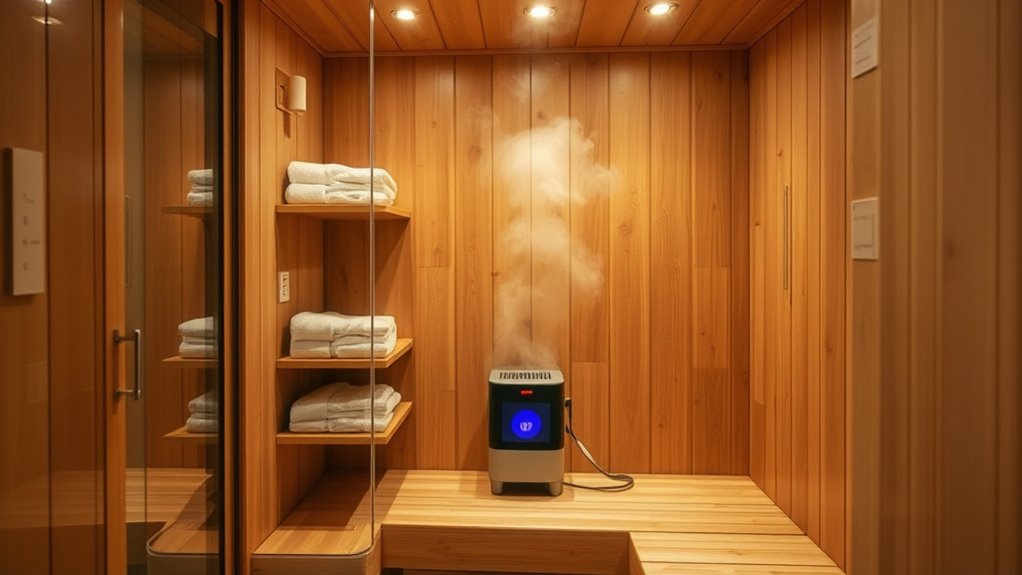
Creating a sauna in a small apartment or condo might seem challenging, but with careful planning and the right equipment, it’s entirely possible. One of your best options is to consider portable sauna units. These are designed specifically for tight spaces and don’t require permanent installation, making them ideal for apartment living. Portable saunas typically come as foldable or pop-up models that you can set up in a corner of your living room or bedroom. They use infrared heaters, which are energy-efficient, produce less humidity, and generate less heat than traditional steam saunas. This makes them more suitable for small spaces and shared living environments. Plus, many portable options come with adjustable temperature controls and timers, so you can customize your sauna experience easily.
However, even with a portable sauna, ventilation challenges remain. Small apartments often lack proper ventilation, and adding a sauna can increase humidity and heat levels considerably. Without proper airflow, you risk moisture buildup that can damage walls or promote mold growth. To combat this, you’ll need to prioritize good ventilation solutions. Use exhaust fans or portable air purifiers with HEPA filters to circulate air and reduce humidity. Opening windows during and after your sauna session can also help, if your apartment layout allows it. Installing a vent or fan near the sauna area can make a big difference in preventing excessive moisture accumulation. You might also want to invest in a dehumidifier to keep humidity levels in check, especially if you plan to use the sauna frequently. Additionally, understanding regulatory compliance ensures your setup adheres to building rules and avoids issues with management.
Positioning your sauna is essential. Choose a spot that’s close to an exterior wall with easy access to ventilation options. Avoid placing it in the middle of the apartment or near areas that might be sensitive to moisture, like bedrooms or electronics. If you opt for a portable unit, make sure it has enough clearance for safe operation and proper airflow. Keep in mind that some building regulations or HOA rules might restrict certain modifications or equipment, so check with management before setting up your sauna. You’ll also want to consider the noise level—infrared saunas are usually quieter than traditional steam models—but it’s worth ensuring your setup doesn’t disturb neighbors.
In short, creating a sauna in a small apartment involves balancing portability with effective ventilation. The key is choosing a lightweight, easy-to-assemble unit and implementing smart ventilation solutions to keep your space comfortable and free of excess moisture. With thoughtful planning, you can enjoy the benefits of a personal sauna without sacrificing your living space or peace of mind.
Frequently Asked Questions
What Are the Legal Restrictions for Installing a Sauna in an Apartment?
You need to check building codes and fire safety regulations before installing a sauna in your apartment. Many jurisdictions require permits and adherence to specific electrical and ventilation standards to prevent fire hazards. You may also face restrictions from your building management or homeowners’ association. Always consult local authorities and professionals to guarantee your sauna setup complies with all legal requirements, avoiding potential fines or safety issues.
How Much Does a Small Indoor Sauna Typically Cost to Install?
Wondering how much a small indoor sauna costs? On average, you’ll spend between $3,000 and $7,000 for installation, depending on material options and features. Do a cost comparison to find the best fit for your budget. Basic models with simple wood and electric heaters are cheaper, while luxury options with custom materials and advanced features will be pricier. Planning carefully helps you enjoy your relaxing space without overspending.
Can I Install a Sauna Without Professional Help?
Yes, you can do a DIY installation of a sauna, but you need to carefully follow the instructions and guarantee you meet electrical requirements. Make sure you have basic electrical knowledge, as saunas often need specialized wiring and safety measures. If you’re comfortable with DIY projects and understand local codes, it’s possible. However, for safety and compliance, consulting a professional is recommended, especially for electrical work.
What Are the Best Space-Saving Sauna Models for Small Apartments?
You should consider compact design sauna models that fit easily into small spaces. Foldable units are excellent because you can store them away when not in use, saving precious space. Look for saunas with slim profiles and lightweight materials, making setup and storage simple. These space-saving options let you enjoy a relaxing sauna experience without sacrificing your apartment’s comfort or functionality.
How Do I Ensure Proper Ventilation for an Indoor Sauna?
Did you know proper ventilation improves sauna efficiency by 30%? To guarantee good air circulation, install a dedicated ventilation system or exhaust fan designed for small spaces. Keep a vent open during use to allow fresh air in and stale air out. Regularly check that your ventilation system works properly, preventing moisture buildup and mold. This way, you create a safe, comfortable environment for your indoor sauna experience.
Conclusion
Building a sauna in your small apartment or condo is about creating a personal retreat, a peaceful escape, a wellness sanctuary. It’s about transforming limited space into a relaxing haven, turning your everyday routine into a rejuvenating ritual, and blending comfort with convenience. With careful planning, smart design, and a touch of creativity, you can enjoy the warmth of a sauna anytime, anywhere—making your home not just a living space, but a sanctuary for relaxation and renewal.
